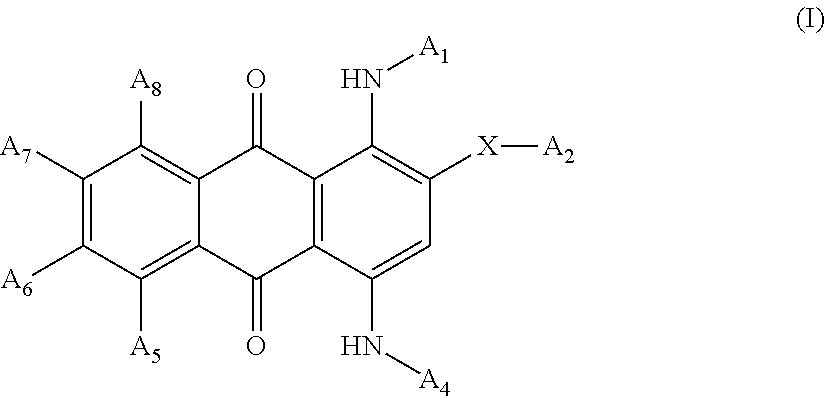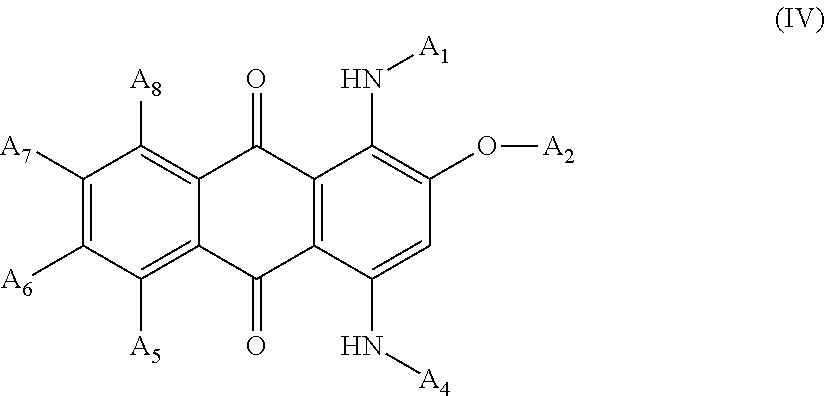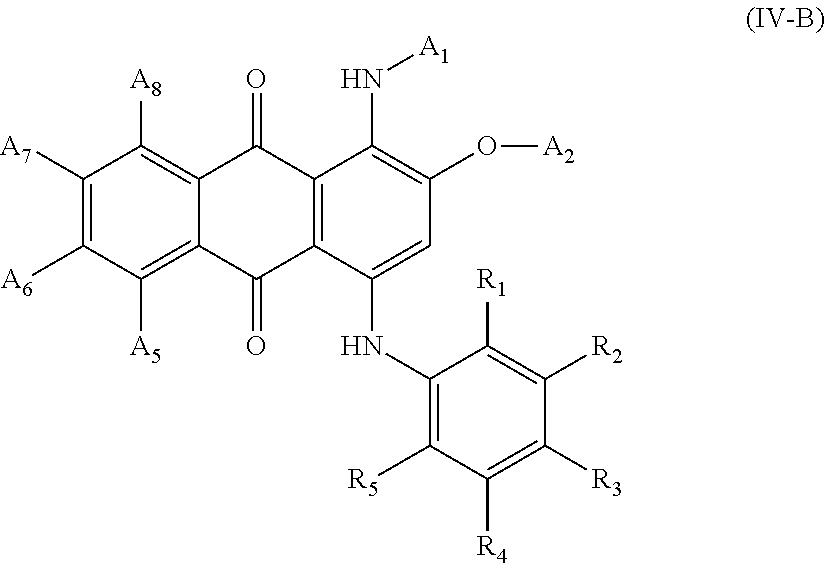Polymeric violet anthraquinone colorant compositions and methods for producing the same
a technology of polymeric violet anthraquinone and colorant composition, which is applied in the direction of amino-hydroxy-anthraquinone dye, organic dye, etc., can solve the problems of inapplicability to textile substrates, fabrics, skin, etc., and achieves the effect of reducing the number of stains on textile substrates, reducing the number of stains, and improving the quality of stains
- Summary
- Abstract
- Description
- Claims
- Application Information
AI Technical Summary
Benefits of technology
Problems solved by technology
Method used
Image
Examples
example 1
[0132]A mixture was prepared containing 9.17 grams of Acid Blue 129, 2.4 grams of 50% sodium hydroxide solution and 30.0 grams of poly(ethylene glycol) mono methyl ether (having molecular weight=550). The mixture was heated to 100° C. for 3 hours. TLC analysis was used to confirm that all of the Acid Blue 129 had reacted. 10 mL of water was then added, and the reaction mixture was neutralized to pH 7 with muriatic acid. The resulting product was a liquid polymeric violet anthraquinone colorant with an absorption maximum in methanol at 584 nm. The structure of the resulting product is shown below:
[0133]
example 2
[0134]Example 1 was repeated, except that the 50% sodium hydroxide solution was replaced with 3.0 grams of sodium tert-butoxide powder. A liquid polymeric violet anthraquinone colorant having the same name, structure, and absorption value as shown in Example 1 was obtained.
example 3
[0135]A mixture was prepared that contained 8.3 grams of Acid Blue 25, 2.4 grams of 50% aqueous sodium hydroxide solution and 30.0 grams of polyethylene glycol) mono methyl ether (molecular weight=550). The mixture was heated to 100° C. for 3 hours. TLC analysis was used to confirm that all of the Acid Blue 25 was reacted. 20 mL of water was then added, and the reaction mixture was neutralized to pH 7 with hydrochloric acid. The resulting product was a liquid polymeric violet anthraquinone colorant with absorption maximum in methanol at 588 nm. The structure of the resulting product is shown below:
[0136]
PUM
| Property | Measurement | Unit |
|---|---|---|
| length | aaaaa | aaaaa |
| wavelength range | aaaaa | aaaaa |
| temperature | aaaaa | aaaaa |
Abstract
Description
Claims
Application Information
 Login to View More
Login to View More - R&D
- Intellectual Property
- Life Sciences
- Materials
- Tech Scout
- Unparalleled Data Quality
- Higher Quality Content
- 60% Fewer Hallucinations
Browse by: Latest US Patents, China's latest patents, Technical Efficacy Thesaurus, Application Domain, Technology Topic, Popular Technical Reports.
© 2025 PatSnap. All rights reserved.Legal|Privacy policy|Modern Slavery Act Transparency Statement|Sitemap|About US| Contact US: help@patsnap.com



